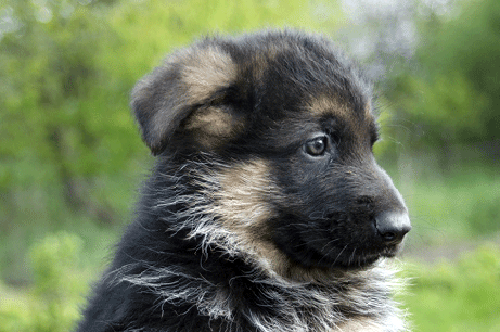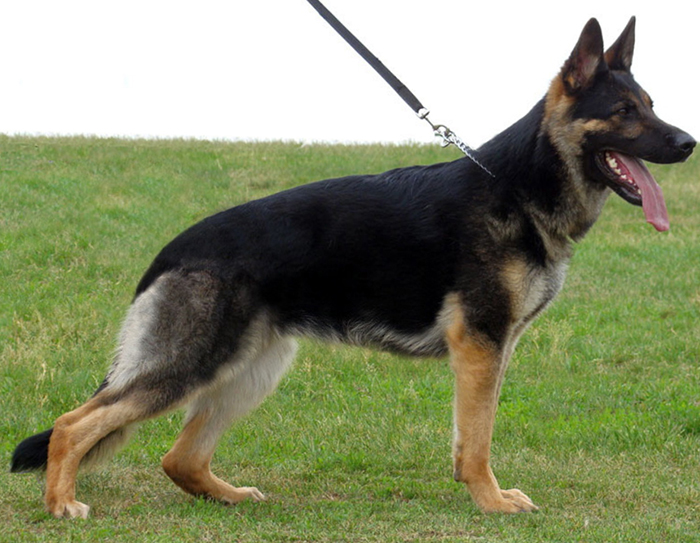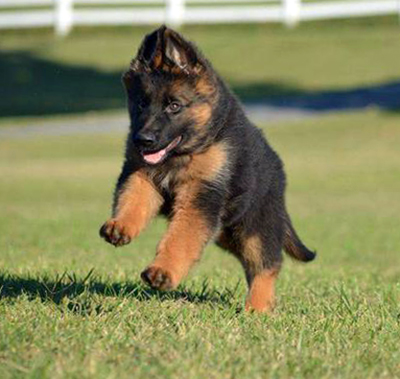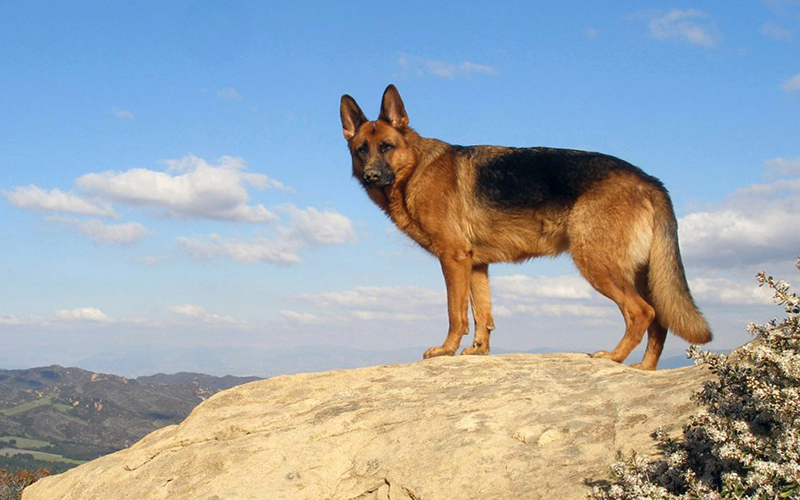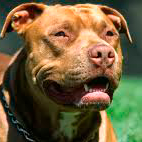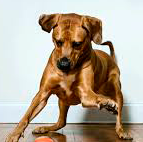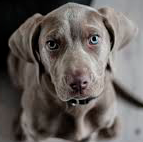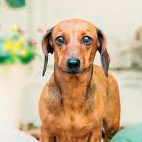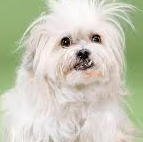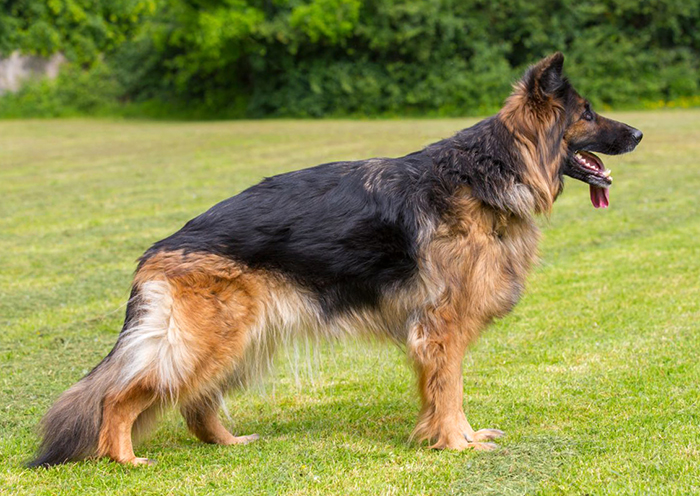
German Shepherd
German Shepherd pictures ➜
Origin:
Germany
Utilization:
Versatile working, watch and professional working dog.
Brief Historical Summary
Following the official establishment of the Association for German Shepherd Dogs (Verein für Deutsche Schäferhunde) situated in Augsburg, a member of the Verband für das Deutsche Hundewesen (VDH) and regarded as the founder association responsible for the breed standard of the German Shepherd Dog, this standard was drawn up at the first meeting of members in Frankfurt/Main on September 20, 1899, following suggestions by A.Meyer and von Stephanitz, as well as supplements from the 6th meeting of members on July 28, 1901, the 23rd meeting of members in Cologne on September 17, 1909, the meeting of Officers and Committee in Wiesbaden on September 5, 1930 and a meeting of the breed Committee and Officers on March 25, 1961 under the auspices of the World Union of Clubs for German Shepherd Dogs (WUSV). It was revised and at the WUSV conference on August 30, 1976, finalised, re-worded and catalogued with authorisation from the Executive and Board on March 23, 1991.
The German Shepherd Dog whose planned breeding was begun in the year 1899 following the founding of the Association, is based on breeding from Central and Southern German lines of the, then available, Watchdogs with the goal of producing a working dog, cut out for high performance. To achieve this goal, the breed standard of the German Shepherd Dog was drawn up with concern for the structure of the body as well as qualities of temperament and character.
General Appearance
The German Shepherd Dog is of medium size, slightly elongated, strong and well muscled. The bone is clean and general construction firm.
Important Measurements / Proportions
Height at Withers: Dogs 60 to 65 cm
Bitches 55 to 60 cm
Length of body approximately 10 to 17 % longer than height at withers.
Temperament
The German Shepherd Dog must be even in temperament, well balanced, self assured, totally unself-conscious and, except when provoked, totally good natured. Added to that he must be attentive and easily trained. He must possess courage, combativity and toughness, so as to be a suitable companion, watch, guard, working and herding dog.
Head
The head is wedge shaped and in proportion to body size (length approximately 40% of height at withers) without being coarse or over -stretched. Clean in general appearance, moderately wide between the ears. The forehead seen from the front and side is only barely arched and without any or, only slightly indicated, middle furrow.
The proportion of the Cranial Region to the Facial Region is one of 50% to 50%. The width of the Cranial Region corresponds approximately to the length. The Cranial Region (skull) seen from above, runs from the ears to the bridge of the nose, tapering evenly and gradually slanting to the not sharply defined stop into the wedge shaped facial region (muzzle) of the head. Upper and lower jaw are strongly made.
Bridge of nose is straight, any hollow or arch is undesirable. Lips taut, closing firmly and of dark colour.
Nose: Must be black.
Teeth: Must be strong, healthy and complete (42 teeth according to usual tooth formation). The German Shepherd Dog has a scissor bite i.e. the incisors must fit scissor-like into each other so that the incisors of the upper jaw overlap those of the lower jaw in scissor fashion. Level bite, over- or undershot are faults as are larger spaces between teeth (gaps). Equally faulty is a straight alignment of the incisors. The jaw bones must be strongly developed so that the teeth can be strongly embedded in it.
Eyes: Of medium size, almond shaped, set slightly slanting, not protruding. The eye colour should be as dark as possible. A light piercing eye is undesirable as it affects the dog’s expression.
Ears: The German Shepherd Dog has erect ears of medium size which are carried upright, pointing in the same direction (not drawn sideways). They taper to a point and the external ear faces forward. Semi-drop ears or pendant ears count as faults. Ears carried laid back in movement or repose are not a fault.
Neck: The neck should be strong, well muscled and not throaty (no dewlap). The angle towards the body (horizontal) is approximately 45 degrees.
Body: The topline runs from the set on of neck to the well defined withers and along the back, sloping very slightly from the horizontal to the lightly sloping croup without any visible break. The back is firm, strong and well muscled. The croup should be long and slope slightly (about 23 degrees from horizontal) and merge without break in the topline with the tail set on.
Chest: Moderately broad, lower chest as long as possible and well defined. Depth of chest should be 45 to 48% of height at withers. Ribs should have moderate spring. A barrel shaped chest is as much a fault as lack of spring.
Tail: Reaches at least to the hocks, yet not further than middle of the metatarsal. It has slightly longer hair on the underside and is carried hanging in a gentle curve. When animated or moving it is carried higher but not above horizontal. Corrective surgery is forbidden.
Limbs
Forequarters: The forelegs are straight, seen from all sides, absolutely parallel seen from the front. Shoulder-blade and upper arm
are of equal length and, due to strong muscling, firmly placed against the body. The angle of the shoulder-blade and upper arm is ideally 90 degrees, but more generally 110 degrees.
Elbows must turn neither in nor out, either standing or moving. Seen from all sides forearms straight and, absolutely parallel to each other, clean and firmly muscled. Front pastern has a length of approximately
1/3rd of the forearm to which it has an angle of 20 to 22 degrees. A pastern which is too steep (less than 20 degrees), restricts the dog’s use, in particular his endurance.
Feet: Rounded, well closed and arched. The soles hard but not rough.
Nails: Strong and dark in colour.
Hindquarters: The position of the hindlegs is slightly backwards, though the hind legs are parallel seen from the rear. Upper and second thigh are almost equal length and form an angle of about 12O degrees. Thighs strong and well muscled. The hockjoints are strong and firm. Metatarsal stands vertically under hockjoint.
Feet: Closed, slightly arched, pads hard and dark in colour. Nails strong, arched and equally of dark colour.
Gait: The German Shepherd Dog is a trotter. The limbs must be so co-ordinated in length and angulation that the dog can, without noticeable change in backline, move the hind legs as far forward as the body and also reach out as far with the forelegs. Any tendency to over angulation of the hindquarters reduces firmness and endurance, and, with it, the working ability. With correct body proportions and angulation, a ground covering flat movement which gives an impression of tireless forward propulsion is obtained. With the head pushed forward and a lightly raised tail, an even, quiet trot achieves a gently flowing topline, uninterrupted from tips of ears to tip of tail.
Skin: The skin is (loose) fitting but without any folds.
Coat
Make Up Of Coat: The correct coat for a German Shepherd Dog is of an outer coat with undercoat. The top coat should be as dense as possible,
harsh and close lying. On the head, inside ears, the front part of the legs, on feet and toes short. Slightly longer and coarser on the neck. On the backside of the legs, the hair is longer as far down as pasterns and hocks. Moderate trousers on backs of thighs.
Colour: Black with tan, brown, yellow to pale grey markings. Solid black or solid grey. In greys, darker shading, black saddle and mask. Unobtrusive, small white marks on chest as well as very pale colour on insides of limbs permissible but not desirable. Nose must be black in all colours. Lack of mask, light to piercing eye colour, as well as light to whitish markings on chest and inside limbs, pale nails and red
tip to tail, are to be regarded as lack of pigment. The undercoat shows a light greyish tone. The colour white is not permitted.
Height / Weight:
Dog: Height at withers 60 to 65 cm
Weight 30 to 40 kg
Bitches: Height at withers 55 to 60 cm
Weight 22 to 32 kg
Testicles: Male animals should have two apparently normal testicles fully descended into the scrotum.
Faults: Any departure from the foregoing points should be considered a fault and the seriousness with which the fault should be regarded, should be in exact proportion to its degree.
Serious Faults: Any departure from the above described breed characteristics which influence working ability.
Faulty Ears: Ears set on laterally or too low, tipped ears, inward constricted ears. Ears not firm. Severe lack of pigment. Severe defect in general firmness.
Dental faults: All departures from scissor bite and correct tooth formation which are not considered disqualifying faults.
Disqualifying Faults
- Weak temperament, biters, nervous dogs.
- Dogs with deformed ears or tail.
- Dogs with malformations.
- Dogs with the following dental faults due to lack of:
- 1 premolar 3 plus one other tooth or
- 1 canine or
- 1 premolar 4 or
- 1 molar 1 or 1 molar 2 or
- all together 3 or more teeth.
- Dogs with faulty jaws. Overshot by more than 2 mm. Undershot. Pincer bite formed by all 12 incisors.
- Dogs which are over or under size by more than 1 cm.
- Albinos
- White coat colour (even with dark eyes and nails).
- Long outer coat (long, soft, not close lying top coat with undercoat, fringes on ears and legs, bushy trousers and bushy tail with plume underneath).
- Long coat (long, soft top coat without undercoat, mostly parted in middle of back, fringes on ears, legs and tail).


